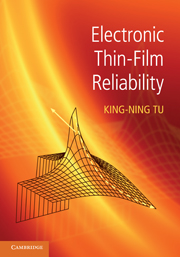Book contents
- Frontmatter
- Dedication
- Contents
- Preface
- 1 Thin-film applications to microelectronic technology
- 2 Thin-film deposition
- 3 Surface energies
- 4 Atomic diffusion in solids
- 5 Applications of the diffusion equation
- 6 Elastic stress and strain in thin films
- 7 Surface kinetic processes on thin films
- 8 Interdiffusion and reaction in thin films
- 9 Grain-boundary diffusion
- 10 Irreversible processes in interconnect and packaging technology
- 11 Electromigration in metals
- 12 Electromigration-induced failure in Al and Cu interconnects
- 13 Thermomigration
- 14 Stress migration in thin films
- 15 Reliability science and analysis
- Appendix A A brief review of thermodynamic functions
- Appendix B Defect concentration in solids
- Appendix C Derivation of Huntington's electron wind force
- Appendix D Elastic constants tables and conversions
- Appendix E Terrace size distribution in Si MBE
- Appendix F Interdiffusion coefficient
- Appendix G Tables of physical properties
- Index
- References
6 - Elastic stress and strain in thin films
Published online by Cambridge University Press: 05 July 2014
- Frontmatter
- Dedication
- Contents
- Preface
- 1 Thin-film applications to microelectronic technology
- 2 Thin-film deposition
- 3 Surface energies
- 4 Atomic diffusion in solids
- 5 Applications of the diffusion equation
- 6 Elastic stress and strain in thin films
- 7 Surface kinetic processes on thin films
- 8 Interdiffusion and reaction in thin films
- 9 Grain-boundary diffusion
- 10 Irreversible processes in interconnect and packaging technology
- 11 Electromigration in metals
- 12 Electromigration-induced failure in Al and Cu interconnects
- 13 Thermomigration
- 14 Stress migration in thin films
- 15 Reliability science and analysis
- Appendix A A brief review of thermodynamic functions
- Appendix B Defect concentration in solids
- Appendix C Derivation of Huntington's electron wind force
- Appendix D Elastic constants tables and conversions
- Appendix E Terrace size distribution in Si MBE
- Appendix F Interdiffusion coefficient
- Appendix G Tables of physical properties
- Index
- References
Summary
Introduction
Thin films are not used as structural parts in electronic devices to carry mechanical loads. Nevertheless, stress or strain does exist commonly in thin films as a result of constraints imposed by their substrates. A thin film and its substrate generally have different thermal expansion coefficients, so stress is produced during temperature excursion in deposition and annealing. Stress in thin films is known to cause serious yield and reliability problems in microelectronic devices. Ni thin film is known to have a high tensile stress deposited by e-gun or by sputtering at room temperature. In epitaxially grown silicon or a silicon-germanium layer, stress can affect the mobility of the carriers, and stress is introduced in devices for the purpose. In this chapter, we shall discuss the nature of biaxial stress in thin films, and the measurement of biaxial stress in thin films using the wafer-bending method. The chemical potential in a stressed solid that affects atomic diffusion and the time-dependent response of a solid to applied stresses in creep or stress-migration will be covered in Chapter 14.
A piece of solid is under stress when its atoms are displaced from their equilibrium positions by a force [1–6]. The displacement is governed by the interatomic potential.
- Type
- Chapter
- Information
- Electronic Thin-Film Reliability , pp. 118 - 140Publisher: Cambridge University PressPrint publication year: 2010



